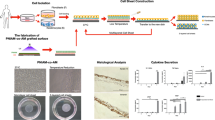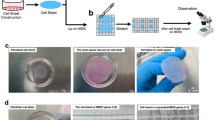Abstract
Following the advantages of single cell transplantation in comparison to sheet grafts we improved a spinning culture system for keratinocytes on completely biodegradable micro-carriers. Since previous in vivo investigations with different carrier materials (Cytodex® and PLGA) [Voigt et al. Tissue Eng 8(2):263–272, 2002; Voigt et al. Tissue Eng 5:563–572, 1999] revealed severe cellular inflammatory reactions and persistent remnants of micro-carriers in wounds, the aim of this study was to find a completely biodegradable, physiological and non-toxic material for new micro-carriers. We succeeded in setting up a keratinocyte spinning culture system using fibrin carriers. We were able to reconstitute the epidermis in full thickness wounds in an athymic nude mouse model and in an immunocompetent porcine wound model.









Similar content being viewed by others
References
Ahmed SA, Gogal RM Jr, Walsh JE (1994) A new rapid and simple non-radioactive assay to monitor and determine the proliferation of lymphocytes: an alternative to [3H]thymidine incorporation assay. J Immunol Methods 170:211–224
Bannasch H, Föhn M, Unterberg T, Bach AD, Weyand B, Stark GB (2003) Skin tissue engineering. Clin Plast Surg 30(4):573–579
Boyce ST, Ham RG (1983) Calcium-regulated differentiation of normal human epidermal keratinocytes in chemically defined clonal culture and serum-free serial culture. J Invest Dermatol 81:33s–40s
Brown KW, Parkinson EK (1985) Alteration of the extracellular matrix of cultured human keratinocytes by transformation and during differentiation. Int J Cancer 35:799–807
Chevallay B, Herbage D (2000) Collagen-based biomaterials as 3D scaffold for cell cultures: applications for tissue engineering and gene therapy. Med Biol Eng Comput 38:211–218
Hecht J, Hoefter EA, Hecht J et al (1997) Cultivated keratinocytes on micro-carriers: in vitro studies of a new carrier system. German. Handchir Mikrochir Plast Chir 29:101–106
Herzog SR, Meyer A, Woodley D, Peterson HD (1988) Wound coverage with cultured autologous keratinocytes: use after burn wound excision, including biopsy followup. J Trauma Inj Infect Crit Care 28:195–198
Juhasz I, Murphy GF, Yan HC, Herlyn M, Albelda SM (1993) Regulation of extracellular matrix proteins and integrin cell substratum adhesion receptors on epithelium during cutaneous human wound healing in vivo. Am J Pathol 143:1458–1469
Stark GB, Kaiser HW (1994) Cologne Burn Centre experience with glycerol-preserved allogeneic skin: part II: combination with autologous cultured keratinocytes. Burns 20(Suppl 1):S34–S38
Stark GB, Kaiser HW, Horch R, Kopp J, Spilker G (1995) Cultured autologous keratinocytes suspended in fibrin glue (KFGS) with allogenic overgraft for definitive burn wound coverage. Eur J Plast Surg 18:267–271
Voigt M, Andree C, Kalt T et al (2002) Human recombinant EGF Protein delivered by a biodegradable cell transplantation system. Tissue Eng 8(2):263–272
Voigt M, Schauer M, Schaefer DJ, Andree C, Horch R, Stark GB (1999) Cultured epidermal keratinocytes on a microspherical transport system are feasible to reconstitute the epidermis in full-thickness wounds. Tissue Eng 5:563–572
Woodley DT, Peterson HD, Herzog SR et al (1988) Burn wounds resurfaced by cultured epidermal autografts show abnormal reconstitution of anchoring fibrils. JAMA 259:2566–2571
Author information
Authors and Affiliations
Corresponding author
Rights and permissions
About this article
Cite this article
Voigt, M., Andree, C., Cosentino, N. et al. Keratinocytes seeded fibrin micro-carriers reconstitute an epidermis in full thickness wounds. Eur J Plast Surg 29, 163–168 (2006). https://doi.org/10.1007/s00238-006-0083-9
Received:
Accepted:
Published:
Issue Date:
DOI: https://doi.org/10.1007/s00238-006-0083-9




